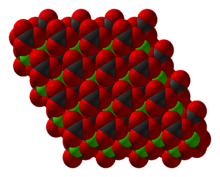Cobalt(II) carbonate
 | |
_carbonate.jpg) | |
| Names | |
|---|---|
| IUPAC name
Cobalt(II) carbonate | |
| Other names
Cobaltous carbonate; cobalt(II) salt | |
| Identifiers | |
| |
3D model (JSmol) |
|
| ChemSpider | |
| ECHA InfoCard | 100.007.428 |
PubChem CID |
|
| |
| |
| Properties | |
| CoCO3 | |
| Appearance | red/ pink crystals (anhydrous) pink, violet, red crystalline powder (hexahydrate) |
| Density | 4.13 g/cm3 |
| Melting point | 427 °C (801 °F; 700 K) [1] decomposes before melting to cobalt(II) oxide (anhydrous) 140 °C (284 °F; 413 K) decomposes (hexahydrate) |
| Cobalt (II) Carbonate is insoluble in distilled water. | |
Solubility product (Ksp) |
1.0·10−10[2] |
| Solubility | soluble in acid negligible in alcohol, methyl acetate insoluble in ethanol |
Refractive index (nD) |
1.855 |
| Structure | |
| Rhombohedral (anhydrous) Trigonal (hexahydrate) | |
| Thermochemistry | |
Std molar entropy (S |
79.9 J/mol·K[1] |
Std enthalpy of formation (ΔfH |
−722.6 kJ/mol[1] |
Gibbs free energy (ΔfG˚) |
-651 kJ/mol[1] |
| Hazards | |
| GHS pictograms |   |
| GHS signal word | Warning |
| H302, H315, H317, H319, H335, H351[3] | |
| P261, P280, P305+351+338[3] | |
| NFPA 704 | |
| Lethal dose or concentration (LD, LC): | |
LD50 (median dose) |
640 mg/kg (oral, rats) |
Except where otherwise noted, data are given for materials in their standard state (at 25 °C [77 °F], 100 kPa). | |
| Infobox references | |
Cobalt(II) carbonate is the inorganic compound with the formula CoCO3. This reddish paramagnetic solid is an intermediate in the hydrometallurgical purification of cobalt from its ores. It is an inorganic pigment, and a precursor to catalysts.[4] Cobalt(II) carbonate also occurs as the rare red/pink mineral spherocobaltite.[5]
Preparation and structure
It is prepared by combining solutions cobaltous sulfate and sodium bicarbonate:
- CoSO4 + 2 NaHCO3 → CoCO3 + Na2SO4 + H2O + CO2
CoCO3 adopts a structure like calcite, consisting of cobalt in an octahedral coordination geometry.[6]
Reactions
Heating the carbonate, proceeds in a typical way for calcining, except that the material is partially oxidized:
- 6 CoCO3 + O2 → 2Co3O4 + 6 CO2
The resulting Co3O4 converts reversibly to CoO at high temperatures.[7] Like most transition metal carbonates, cobalt carbonate is insoluble in water, but is readily attacked by mineral acids:
- CoCO3 + 2 HCl + 5 H2O → [Co(H2O)6]Cl2 + CO2
Uses
Cobalt carbonate is a precursor to cobalt carbonyl and various cobalt salts. It is a component of dietary supplements since cobalt is an essential element. It is a precursor to blue pottery glazes, famously in the case of Delftware.
Natural occurrence
The moderately rare spherocobaltite is the natural form of cobalt carbonate, with good specimens coming especially from the Republic of Congo. "Cobaltocalcite" is a name used for a cobaltiferous calcite variety that is quite similar in habit to spherocobaltite.[5]
Safety
The compound is harmful if swallowed, and irritating to eyes and skin.
References
- 1 2 3 4 http://chemister.ru/Database/properties-en.php?dbid=1&id=573
- ↑ "Archived copy". Archived from the original on 2012-06-15. Retrieved 2012-05-17.
- 1 2 3 Sigma-Aldrich Co., Cobalt(II) carbonate. Retrieved on 2014-05-06.
- ↑ John Dallas Donaldson, Detmar Beyersmann, "Cobalt and Cobalt Compounds" in Ullmann's Encyclopedia of Industrial Chemistry, Wiley-VCH, Weinheim, 2005. doi:10.1002/14356007.a07_281.pub2
- 1 2 "Spherocobaltite: Spherocobaltite mineral information and data". www.mindat.org. Retrieved 7 August 2018.
- ↑ Pertlik, F. (1986). "Structures of hydrothermally synthesized cobalt(II) carbonate and nickel(II) carbonate". Acta Crystallographica Section C. 42: 4–5. doi:10.1107/S0108270186097524.
- ↑ G.A. El-Shobaky, A.S. Ahmad, A.N. Al-Noaimi and H.G. El-Shobaky Journal of Thermal Analysis and Calorimetry 1996, Volume 46, Number 6 , pp.1801-1808. online abstract
External links
| Wikimedia Commons has media related to Cobalt(II) carbonate. |
| H2CO3 | He | ||||||||||||||||
| Li2CO3, LiHCO3 |
BeCO3 | B | C | (NH4)2CO3, NH4HCO3 |
O | F | Ne | ||||||||||
| Na2CO3, NaHCO3, Na3H(CO3)2 |
MgCO3, Mg(HCO3)2 |
Al2(CO3)3 | Si | P | S | Cl | Ar | ||||||||||
| K2CO3, KHCO3 |
CaCO3, Ca(HCO3)2 |
Sc | Ti | V | Cr | MnCO3 | FeCO3 | CoCO3 | NiCO3 | CuCO3 | ZnCO3 | Ga | Ge | As | Se | Br | Kr |
| Rb2CO3 | SrCO3 | Y | Zr | Nb | Mo | Tc | Ru | Rh | Pd | Ag2CO3 | CdCO3 | In | Sn | Sb | Te | I | Xe |
| Cs2CO3, CsHCO3 |
BaCO3 | Hf | Ta | W | Re | Os | Ir | Pt | Au | Hg | Tl2CO3 | PbCO3 | (BiO)2CO3 | Po | At | Rn | |
| Fr | Ra | Rf | Db | Sg | Bh | Hs | Mt | Ds | Rg | Cn | Nh | Fl | Mc | Lv | Ts | Og | |
| ↓ | |||||||||||||||||
| La2(CO3)3 | Ce2(CO3)3 | Pr | Nd | Pm | Sm | Eu | Gd | Tb | Dy | Ho | Er | Tm | Yb | Lu | |||
| Ac | Th | Pa | UO2CO3 | Np | Pu | Am | Cm | Bk | Cf | Es | Fm | Md | No | Lr | |||
